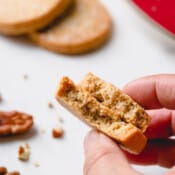With crisp edges and buttery centers, these pecan sandies are top notch! They’re nutty and rich with that classic melt-in-your-mouth texture.
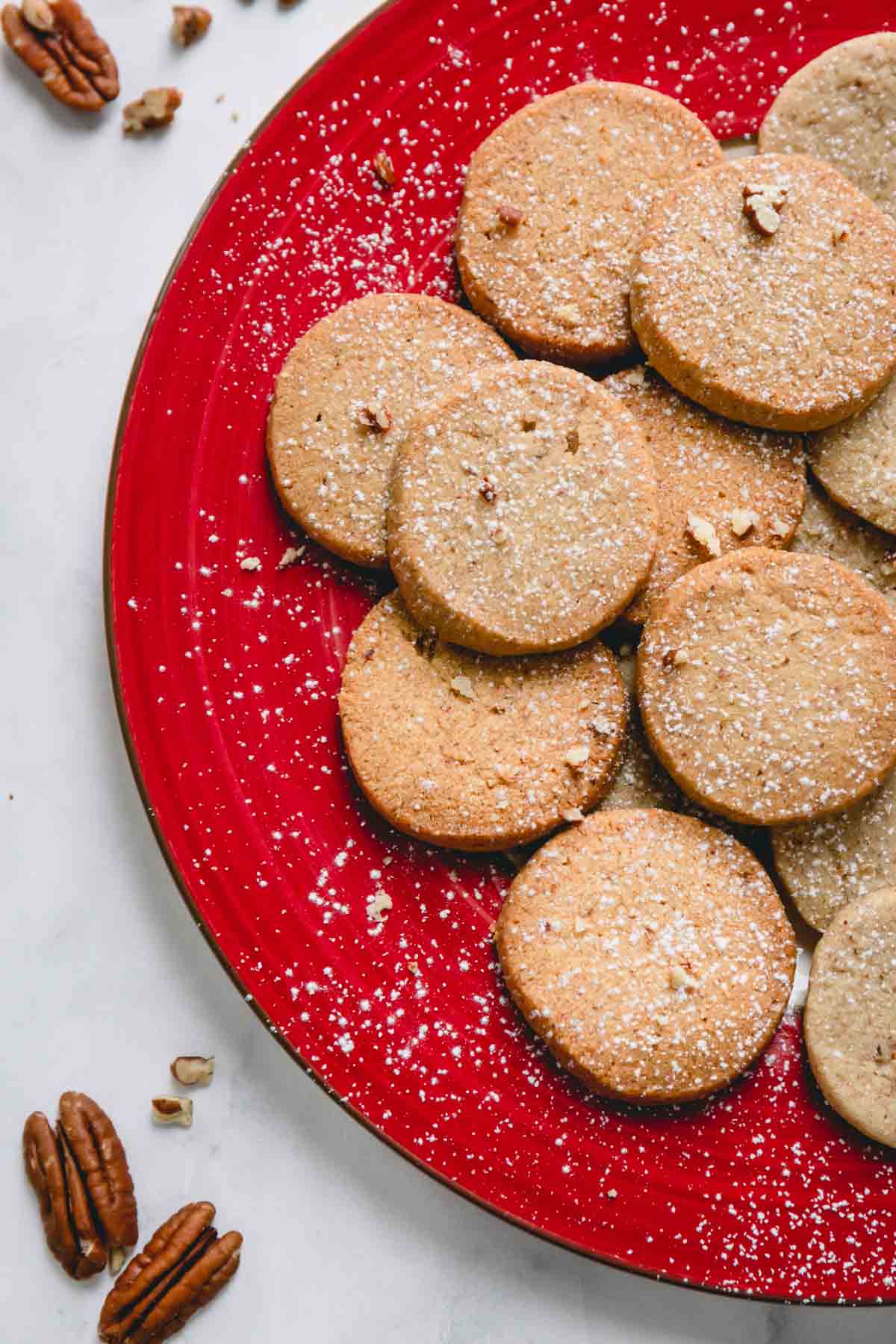
Table of Contents
What are Pecan Sandies?
A pecan sandie is a type of buttery shortbread cookie packed with chopped pecans.
They’re aptly named “sandies” after their crumbly, sandy-like texture and golden color! They’re a Christmas staple around our house and never last long.
Why you’ll love this recipe:
Ever since my friend, Amy, brought pecan sandies to our holiday cookie exchange years ago, they’ve become my go-to for cookie exchanges around the holidays.
They’re nutty, buttery, soft, and crisp all in one delicious bite.
- Easy pecan sandies recipe with just 6 ingredients!
- Buttery shortbread cookie with crunchy pecans
- Worlds better than Keebler pecan sandies. (And I love them too!)
Key Ingredient Notes:
- Pecan gives you the nutty flavor and sandy texture in this classic cookie! If you don’t like pecans, walnuts work great too.
- Powdered sugar – There’s a reason you don’t typically see powdered sugar in cookies! The end result is a softer, melt-in-your-mouth texture that white sugar can’t achieve. It’s perfect for shortbread-style cookies.
- Unsalted butter – And plenty of it! Sandies are a type of shortbread cookie, which means they have more butter, less flour, and no leavening.
- Egg yolk adds richness and binds the cookies together.
- Salt – A small amount of salt enhances sweetness!
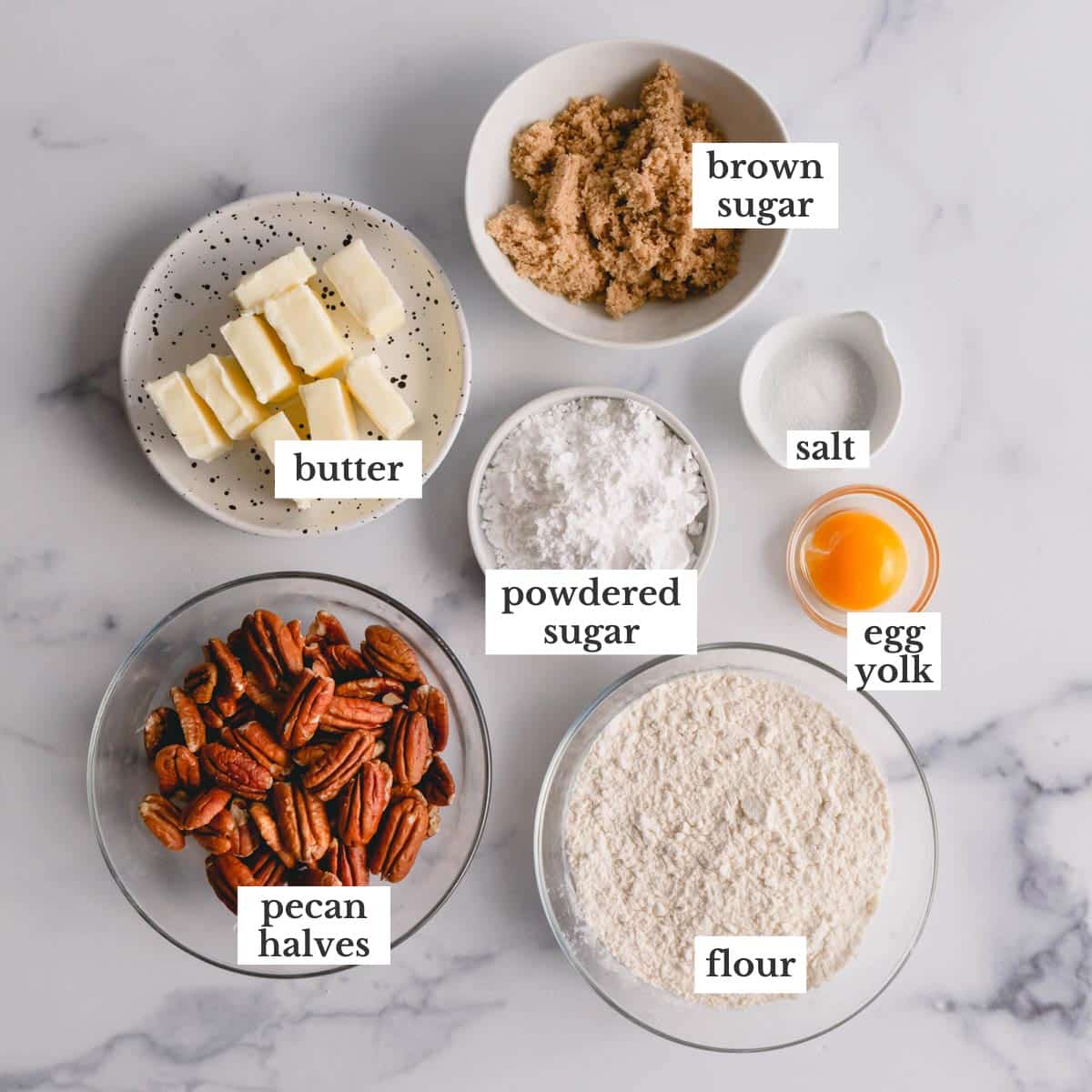
How to make this recipe:
Homemade pecan sandies are a breeze to make! Here’s step-by-step instructions with photos for extra guidance.
1. Make the cookie dough:
- In the bowl of a food processor, combine the pecans, brown sugar, and powdered sugar. Pulse for about 30 seconds.
- Add the flour and salt, then pulse again for 30 seconds.
- Add the butter slices and egg yolk, then process again for 30 seconds, or until the dough forms into a shaggy ball.
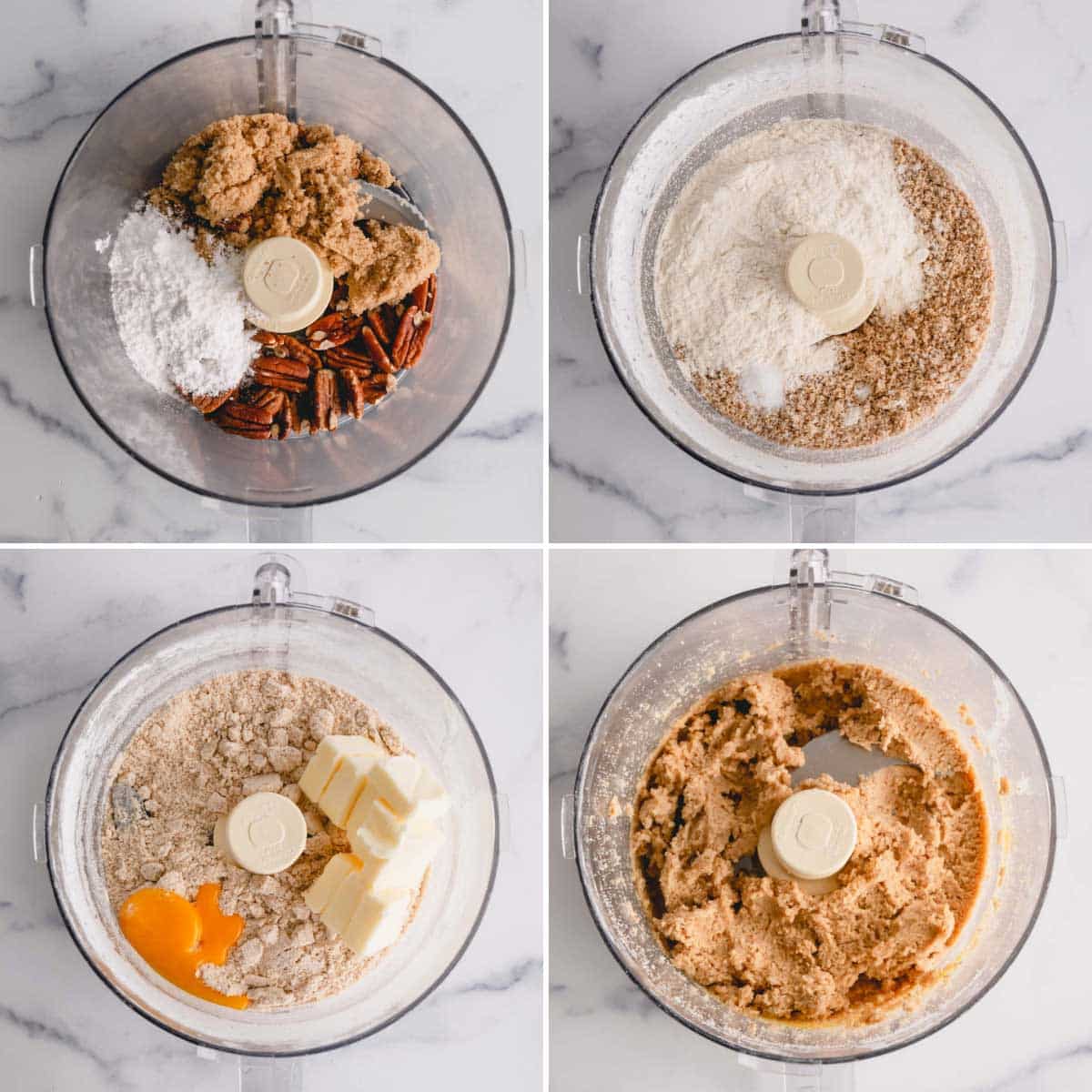
Tip
Don’t run the processor continuously to prevent over-processing the nuts. Pulse, pulse, pulse!
2. Chill the dough:
- Transfer the dough onto a clean work surface and knead until the dough is smooth.
- Roll it into a 12-inch log, then wrap it in plastic wrap and refrigerate for at least 2 hours, or up to 3 days.
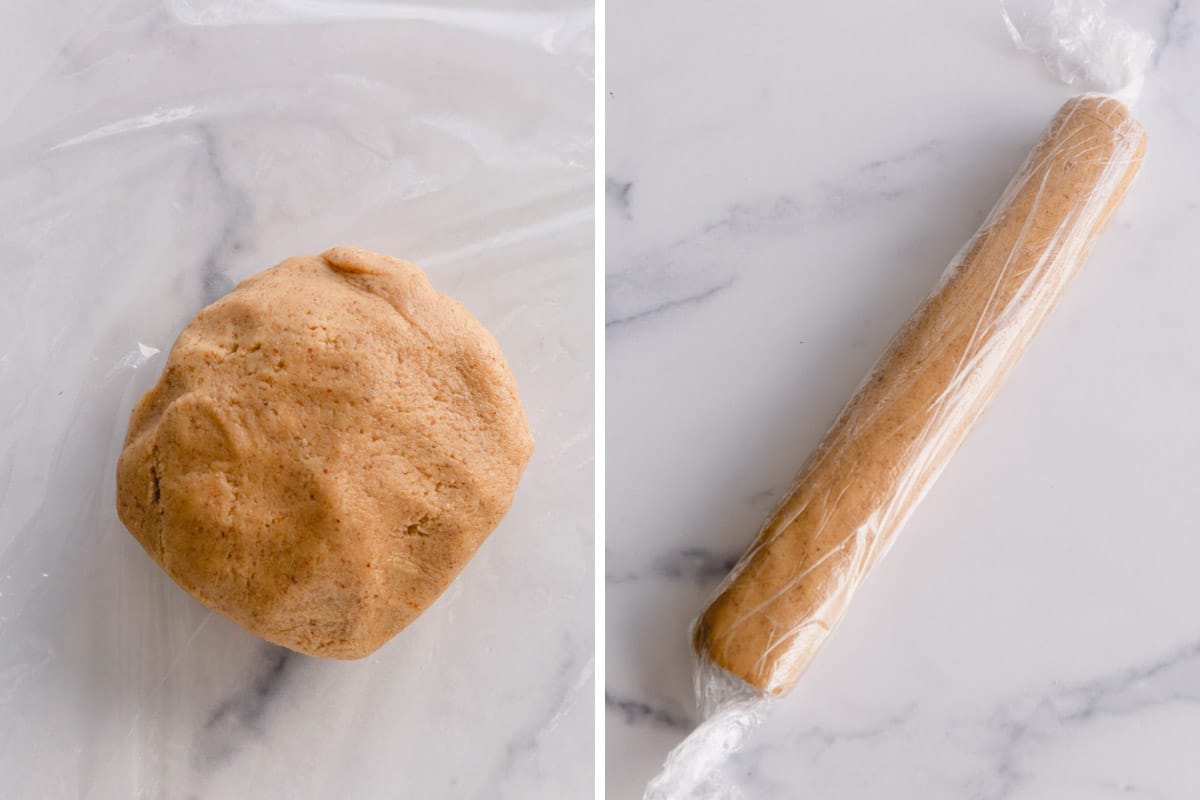
3. Slice the cookie dough:
- Preheat the oven to 350°F (177°C). Give the oven at least 30 minutes to come up to temperature.
- Slice the chilled log into about 1/2-inch thick discs and arrange them on a parchment-lined sheet pan.
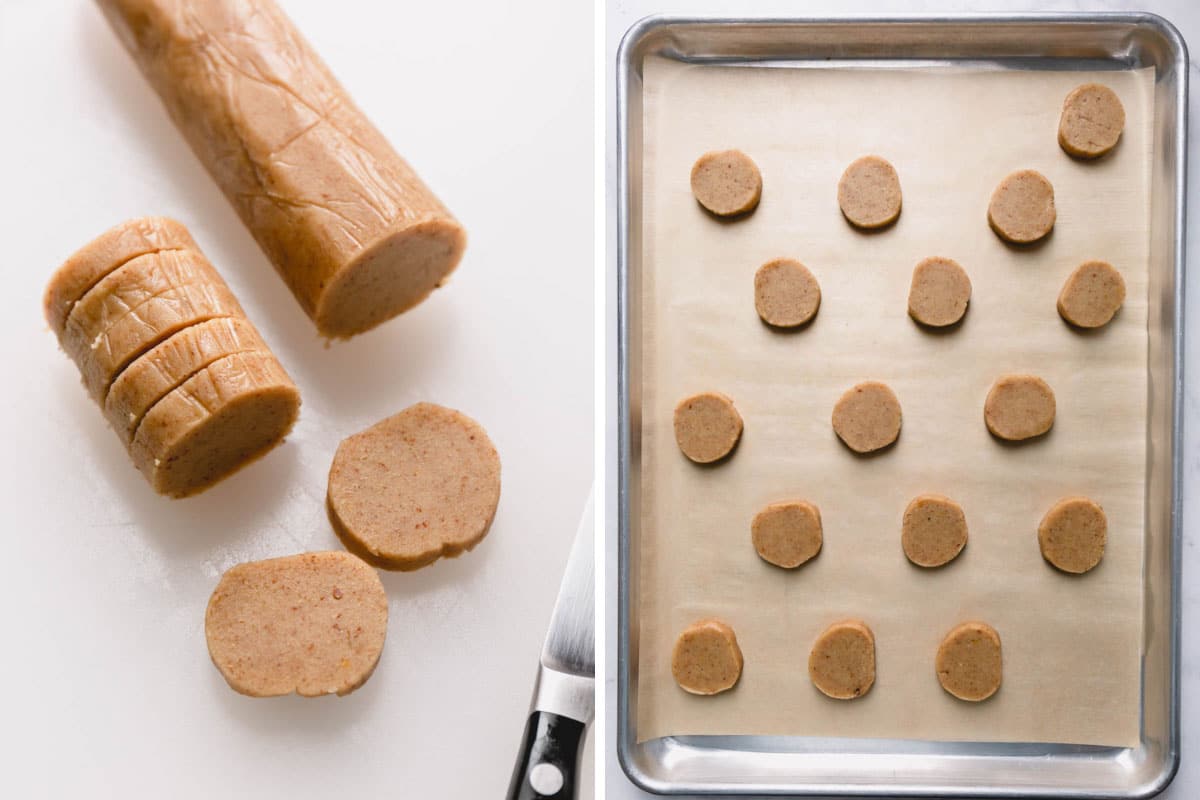
4. Bake the sandies:
- Bake the cookies for 16 to 18 minutes, or until the cookies are lightly golden brown around the edges.
- Let the cookies cool on the sheet pan for a few minutes before you transfer them to a cooling rack.
Tips for Success:
- Measure your flour accurately! The most accurate way to measure flour is with a kitchen scale. If you don’t have one, then use the spoon and level method. Spoon the flour into a measuring cup, then level it off with the flat end of a butter knife.
- You can skip the chilling time, if preferred. Chilling and slicing the cookies gives them clean, sharp edges. If you don’t have time to chill the dough, scoop into 1-inch balls, then flatten with a spatula and bake.
- Don’t forget to line your sheet pans with parchment paper or a silicone baking mat. It prevents sticking and makes cleanup a breeze!
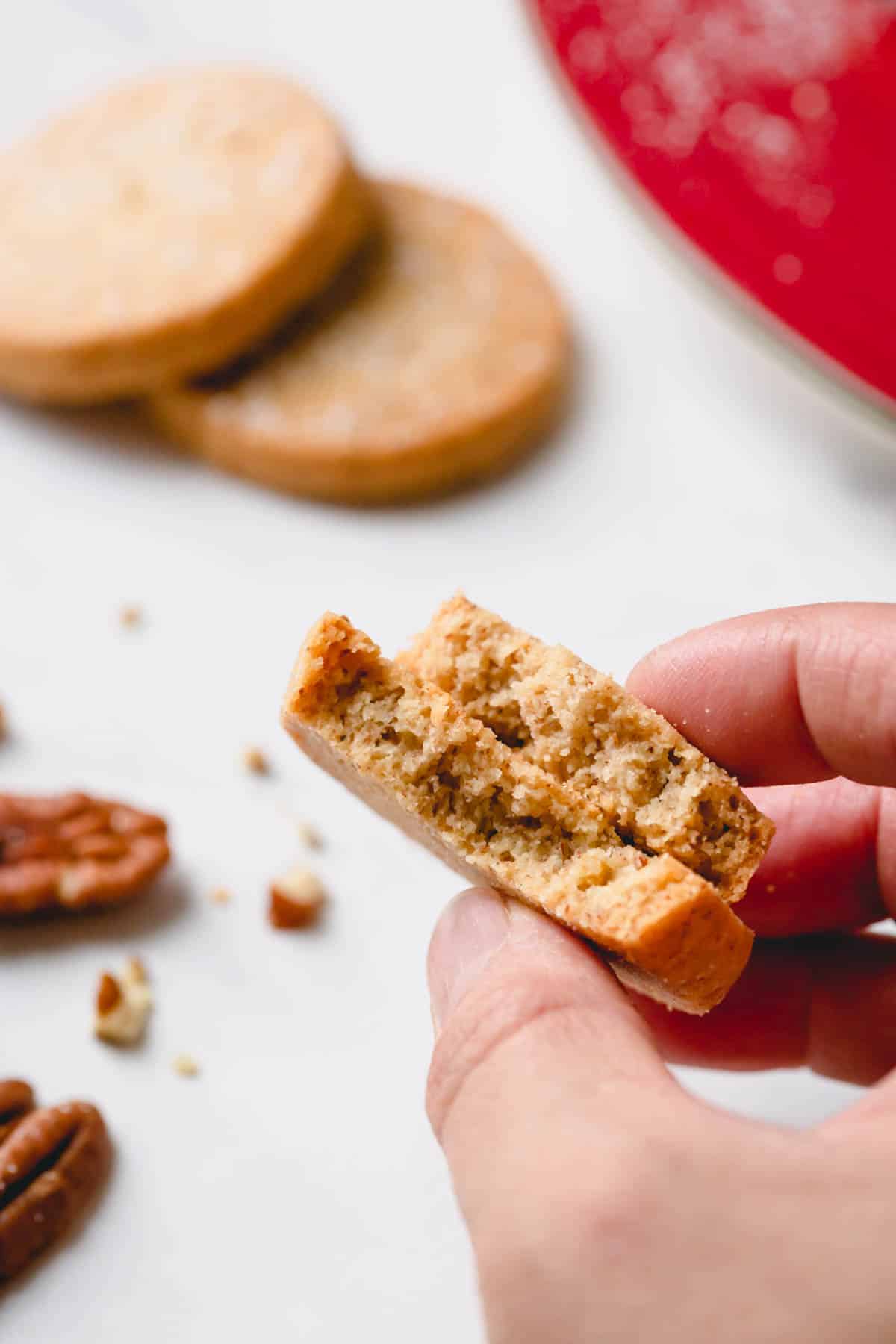
Make-Ahead Tips:
- You can make these cookies ahead of time and freeze the unbaked dough or the baked cookies!
- To freeze unbaked: Wrap the cookie dough logs in plastic wrap and place them in a ziplock freezer bag. Freeze for up to 3 months. Thaw the dough in the refrigerator overnight, then slice and bake as directed.
- To freeze the baked sandies: Let them cool to room temperature, then transfer the cookies to a freezer-safe container. Freeze for up to 3 months.
Storing Tips:
- Store leftover cookies in an airtight container on the counter for up to 3 days, or in the refrigerator for up to one week.
- To extend their shelf life, freeze them instead! Transfer the pecan sandies to a freezer-safe container or ziplock bag and freeze for up to 3 months. After that, they develop freezer burn and the flavor suffers.
- Thaw cookies on the counter or pop one in the microwave in 10-second increments until defrosted.
FAQs:
Sandies get their name from their sandy-like texture and light brown color. They are a type of shortbread, which means they have more butter, less flour, and no leavening. This gives them a signature melt-in-your-mouth, crumbly texture.
Pecan sandies are rich, buttery, and not overly sweet. They have crisp, golden brown edges and a nutty flavor from the pecans! They taste like a slightly sweet shortbread cookie with bits of pecans throughout.
These pecan sandies are made of butter, flour, sugar, an egg yolk, and pecans! The fat-to-flour ratio is higher than normal cookies, and the cookies have pecans dispersed throughout to give them their signature flavor.
Crave-Worthy Cookie Recipes
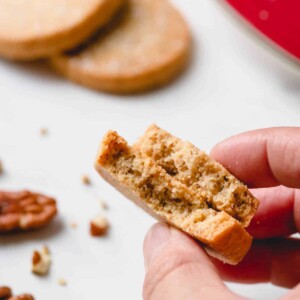
Classic Pecan Sandies
Ingredients
- 1 cup (120g) pecan halves Note 1
- ⅓ cup (70g) light brown sugar
- ¼ cup (30g) powdered sugar
- 1 cup (125g) all-purpose flour
- ¼ teaspoon salt
- 1 stick (115g) unsalted butter cut into ½-inch slices
- 1 egg yolk
Equipment
- food processor
- Measuring cups & spoons
- baking sheet
Instructions
- In a food processor, combine pecan halves, brown sugar and powdered sugar. Pulse for about 30 seconds.
- Add flour and salt and pulse again for another 30 seconds.
- Add butter slices and egg yolk and process for 30 seconds, or until the dough forms into a shaggy ball.
- Transfer the dough onto the counter and knead until the dough is smooth. Roll it into a 12-inch log, cut it in half, and wrap each log with plastic wrap. Refrigerate for at least 2 hours, or up to 3 days.
- 30 minutes prior to baking, preheat the oven to 350°F (177°C).
- Slice the chilled log into ½-inch thick discs and arrange them on a baking sheet lined with parchment paper. (I first cut the log into 2 equal parts, then each half into another half. And finally slice each disc into halves again.)
- Bake the cookies for about 16-18 minutes, or until the cookies are light golden brown around the edges.
- Cool the cookies on the baking sheet for a few minutes, then transfer them onto a cooling rack to cool completely.
Tips & Notes
– Store leftover cookies in an airtight container on the counter for up to 3 days, or in the refrigerator for up to one week.
– To extend their shelf life, freeze them instead! Transfer the pecan sandies to a freezer-safe container or ziplock bag and freeze for up to 3 months. After that, they develop freezer burn and the flavor suffers.
– Thaw cookies on the counter or pop one in the microwave in 10-second increments until defrosted.
